For a second topic in our “trading platforms” series, after Top stock trading apps, let’s look into CFD trading platforms. One of the types of online trading, contract for difference (CFD) is a contract that allows one of the parties, the seller or the buyer, to profit (or lose) from fluctuations in the price of an asset.
Warning: CFDs are complex instruments and come with a high risk of losing money rapidly due to leverage. Between 67-89% of retail investor accounts lose money when trading CFDs. Also some parameters like margin can be volatile according to market trends.You should consider whether you understand how CFDs work and whether you can afford to take the high risk of losing your money.
Warning. 68% of retail investor accounts lose money when trading CFDs with eToro. You should consider whether you can afford to take the high risk of losing your money. Your capital is at risk. Other fees apply. For more information, visit etoro.com/trading/fees. Also, this content is not intended for US users. eToro USA LLC does not offer CFDs, only real Crypto assets available.
Plus500: 82% of retail investor accounts lose money when trading CFDs with this provider. You should consider whether you can afford to take the high risk of losing your money.
8 top CFD trading platforms
“Where do I start?” – is a frequent question from inquisitive minds. CFD trading platforms is the apt option to start, a computer software as a gateway to a trading service, where one can buy/sell financial assets. Such platform typically provides various trading types, including CFDs, for transactions between traders directly, or via intermediary/broker/agent, allowing to trade remotely from anywhere. CFD trading may involve stocks, currencies, commodities, shares, etc., and is always performed in pairs (USD to EUR, Shell to Exxon). We’ve selected seven best CFD trading platforms based on usability, friendliness towards novices, reasonable commissions and other factors.
Plus500
Account minimum: $100 | Max.leverage 1:30 | Avg.CFD margin: N/A
Plus500: 82% of retail investor accounts lose money when trading CFDs with this provider. You should consider whether you can afford to take the high risk of losing your money.
First of all, keep in mind, that Plus500 is a CFD provider and offer CFD service only. All the instruments are available for trading only through CFDs. To start real trading you have to complete registration which include submitting some personal documents and require reading few special documents and questionnaire.
Plus500UK Ltd it’s a experienced platform authorized & regulated by the FCA (#509909), Plus500CY Ltd authorized & regulated by CySEC (#250/14), while Plus500SEY Ltd is authorised and regulated by the Seychelles Financial Services Authority (Licence No. SD039). Although not available in some countries, Plus500 is a highly popular trading platform (over 5M downloads from the Play Store). Account deposit is at $100 minimum for debit/credit cards, $500 for bank transfers. CFDs for trading may include stocks, forex, indices, commodities, and even cryptocurrencies.
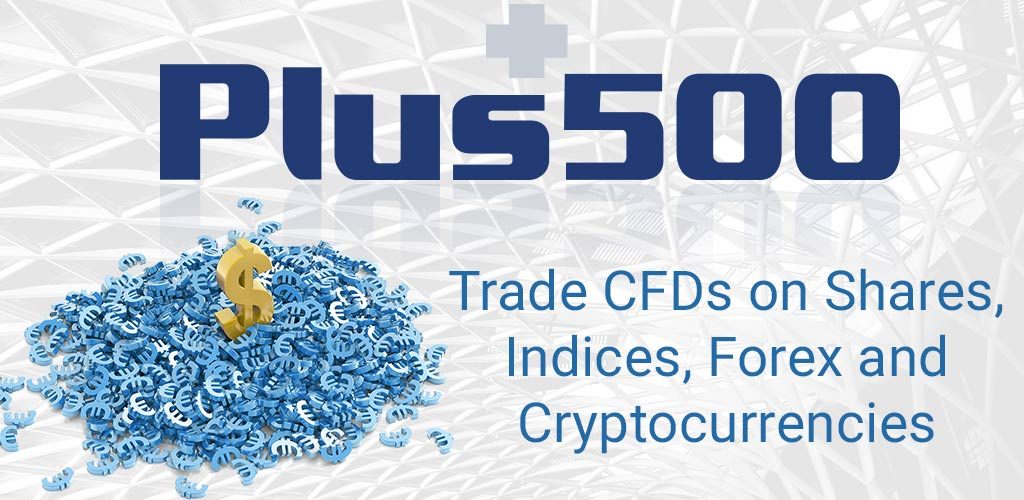
Key features:
- Advanced risk management tools
- Price and real-time market alerts
- Cryptocurrency CFDs (Availability subject to regulation) – Bitcoin, Litecoin, Ethereum
- Free demo account without limitations
- Economic calendar with relevant and real-time events
- Risk management settings – e.g. limits to close at certain profit/loss, trailing stop
- 24/7 online support
What makes Plus500 one of the most attractive CFD trading platforms is a zero commisions (yes, zero) for multiple actions, i.e. deposits, open/close trades, live CFD prices. What users pay is a spread for opening a position (bid). Additional fees may apply for overnight funding, stop orders, account inactivity, currency conversion and if a guaranteed stop order is applied, additional spread is charged. Also, note that when logging into account on two devices, one of those will be disconnected.
Pros
- Keeping customer costs in real bank account
- Simple workflow, quick demo account opening
- Multiple languages, round-the-clock support
Cons
- No MT4 connectivity
- Numerous customer complaints about scams
Plus500: 82% of retail CFD accounts lose money.
eToro
Account minimum: $50| Max.leverage 1:30 | Avg.CFD margin: 30%
Warning. 68% of retail investor accounts lose money when trading CFDs with eToro. You should consider whether you can afford to take the high risk of losing your money. Your capital is at risk. Other fees apply. For more information, visit etoro.com/trading/fees. Also, this content is not intended for US users. eToro USA LLC does not offer CFDs, only real Crypto assets available.
#1 social trading platform by eToro Group Limited, founded in 2007 in Cyprus (with offices in England and Israel). Positioned as innovative web platform for trading, eToro stands out from other CFD trading platforms due to social trading possibilities, a.k.a. mirror trading or copy trading – meaning that users may simply follow the actions of trusted brokers and do the same investments. This made it quite popular in 140 countries, having reached over 3 million accounts.
Key features:
- Social trading + investment platform, 2 in 1
- CopyTrader feature – copy trades and deals
- CopyPortfolios feature – copy markets (asset groups following trading strategies) and copy top trader funds
- Ability to view transactions of any member for the whole period
- Stop loss – set a minimum amount of money on account
- 24/7 market hours
- eToro Economic Calendar – to see events that may impact trades
- Trading Academy – page with webinars, courses, blog
Note, that you can withdraw as little as $30, though a minimum withdrawal fee is $5. There is also a $10 inactivity fee, if you have not logged into account for 12 months. eToro complies with multiple regulations and bodies, takes the issue of cybersecurity seriously and is helpful to customers 24/5. In terms of contracts for difference, check out how CFDs on eToro work. Also, be aware of $5 withdrawal fee on every deal.
Pros
- Quick account opening
- Reasonable fees and commissions
- User-friendly interface, multiple languages
Cons
- High non-trading commissions
- Less trading assets in comparison to other platforms
- Inactivity fee
Vantage FX
Account minimum: $200 | Max.leverage 1:500 | Avg.CFD margin: N/A
VantageFX is a regulated broker for Australia, UK and Islamic countries, offering traders world-wide access to over 180 trading instruments, including Forex, Share CFDs, indices and commodities, through the industry leading MT4 and MT5 platform. All Vantage FX clients experience super-fast trade execution, sharp spreads and a completely transparent trading environment.
It’s quick and easy to open an account with Vantage FX and you can start with a minimum of just $200. As soon as your account is live, you can immediately access a huge range of trading instruments, and start trading in any style, whether scalping, swing trading, position trading, or even automatic trading.
Key features:
- STP and RAW ECN accounts
- Volume related bonuses, interest of margin and other trading tools
- Support for MetaTrader 4 and MetaTrader 5
- 300+ tradable assets including 13 indices, 20 commodities and 100 share CFDs
- Negative balance protection
- 50% welcome bonus equity for deposits of up to $500
- News about 35,000+ tradable assets in premium account
- Active analytical reports for 80,000+ indices
VantageFX doesn’t charge any fees for deposits, withdrawals, or account keeping. And, with 13 trading platforms to choose from, clients can trade from a desktop computer as well as on the go through their mobile device.
Pros
- 24/7 support
- Fast execution
- Multi-functional mobile apps
Cons
- NoAPI
- High initial deposit
Capital.com
Account minimum: $20 | Max.leverage 1:200 | Avg.CFD margin: N/A
Capital.com was founded in 2016 with the idea to launch a trading app standing out of competition. The result was a massive trading platform, utilizing AI (SmartFeed) among many technical tools. SmartFeed technology carefully tracks traders activities and behavior to help identify trends, good deals, etc. In addition to encrypting the user data, Capital partners with RBS and Raiffeisen, one of the biggest banks, to store client funds. Keep note, Capital Com is registered in England and Wales and regulated by FCA (733714 license) and Capital Com SV Investments Ltd is reguated by CySEC under license number 319/17.
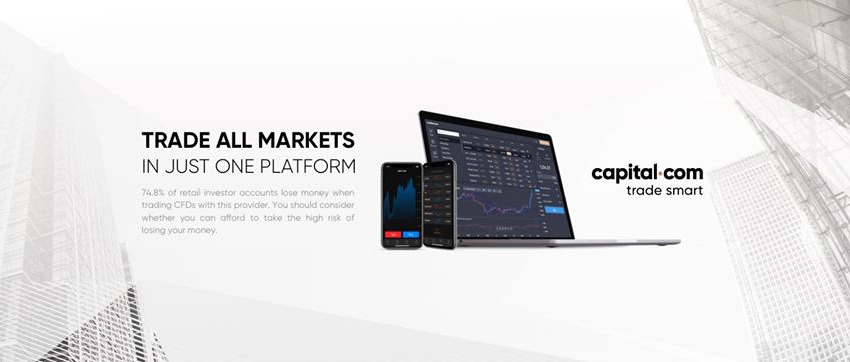
Capital.com provide free access to real-time quotes, more than 75 technical indicators, dynamic charts and extensive drawing tools. The platform shows real-time price fluctuations and historical data, and ranks a number of factors (most-traded and most-volatile assets, top risers and fallers, etc). Funds can be deposited or withdrawn via a range of international methods including debit card, credit card, bank wire transfer, and international payment services such as Webmoney, ApplePay, UnionPay China (in total 18+ providers).
Key features:
- 3000+ Markets: 142 currency pairs, 53 commodities, 34 indices, 2733 stocks, 83 crypto
- No fees for deposits, withdrawals, real-time quotes, opening/closing trades and more
- Web and mobile trading application
- 75+ technical indicators, plus charts, price alerts, etc.
With zero commission for a variety of trades, Capital.com clearly makes one of the leading CFD platforms currently. It also goes the extra mile in explaining and educating about intricacies of contract-for-difference trading. You’ll find guides on leverage, long and short positions, profiting from rising and falling markets, hedging, etc.
Pros
- $20 account minimum fund
- Advanced AI technology at work
- 24/7 withdrawal policy
Cons
- Unclear average CFD margins
- High leverage ratio could lead to big loss
Warning: 71,2% of retail investor accounts lose money when trading CFDs with this provider.
Interactive Brokers
Account minimum: $0 | Max.leverage 1:500 | Avg.CFD margin: 4%
A global top-tier trading entity with 40+ years on market, IB Group now provides powerful trading software platform, TWS (Trader Workstation). It’s a place where investors can trade stocks, options, futures, bonds and funds on 125 markets within single account. Interactive Brokers is an online trading place with HQ in Connecticut, USA. Products include web portal (IBKR WebTrader), desktop app, mobile platform (IBKR Mobile for iOS and Android devices), IBot, API. There is “zero” minimum deposit policy to start off trading, although no account activity may lead to certain fee.

Key features:
- Universal account – view/trade multiple assets, trade CFDs in one window
- Reports – including real-time trade alerts, margin information, cost analysis, etc.
- Smart Routing technology to calculate a CFD reference price (the exchange-quote price for a specific share)
- Transparent quotes – IB charges an honest commission on spreads and price movement, without requotes
- FX Trader – with streaming quotes, indicators, volumes, pending trades, etc.
- IBot – a personal helper for quick information on stocks, account balance, etc.
- Portfolio Analyst – reporting and management tool with 200+ benchmarks
- Offline installer of TWS software
Over 60 order types are accessible in TWS, from basic to complex algorithms for CFD trading. Commissions are lower than other platforms offer – depending on the index, starting rates are within 0.005% – 0.01% range. The platform also has risk management and monitoring tools for assets, and offers coherent real-time data for active traders to be able to react quickly.
Pros
- Powerful and all-round trading software
- Excellent for market and portfolio analysis
- Low fees, transparent commissions
Cons
- TWS will be difficult and time-consuming to start with
- Small or inactive accounts may get maintenance fee
- Regional restrictions in CFD trading
XTB
Account minimum: $250 | Max.leverage 1:10 | Avg.CFD margin: 3.33%
A leading European trading company, X-Trade Brokers, or just XTB, established in Poland in 2002. Beside CFD, FX, ETF, and own xStation 5 platform, it also has access to conventional MT4, and it is available as a web service, mobile app and desktop app. With $250 initial account deposit customers get access to 1,500 global markets. Nice bright design, fast speeds, excellent 24/7 support service, API and all the rest defines XTB as the cutting-edge service for professional traders and brokers.
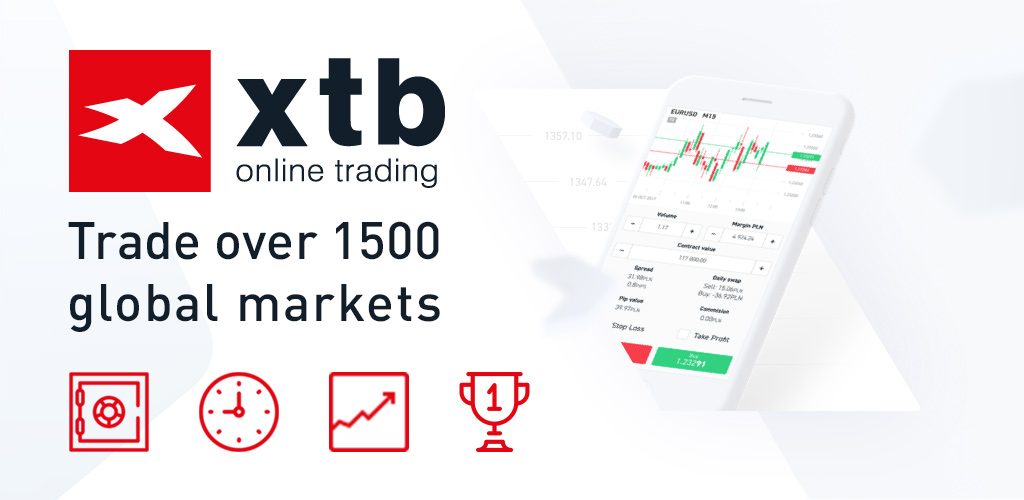
Key features:
- XStation 5 for desktop, tablet, mobile (Android) and smartwatch
- Trading calculator feature – to preview potential profits and losses
- Stop loss guarantee / negative balance protection
- Free market comments from brokers in audio format
- Equity screening to discover trading opportunities
- Advanced technical indicators, e.g. Fibonacci Retracement
- Stock CFDs (1,500 equities) and ETF CFDs (60 units)
- Leverage on CFDs up to 1:10
- Live performance stats
- Free mobile alerts
With vast number of investment products, indices, commodities, etc. available to trade or invest in, they seem to have it all, however XTB seems to be lacking in spread betting. Demo or live account, immediately after signing up, you will get a phone call to help and guide along the way.
Lots of functions are simple drag-and-drop, there’s a lot of analytical tools, screeners, heatmaps and indicators. Also, constant news feed and daily technical analysis and expert op-eds. Popular EUR/USD spread as of Q2 2019 was 0.00007 pips. There’s also a round turn commission of 0.16%.
Pros
- Free educational materials online
- Multiple interface languages
- Customer support via email, chat, phone
Cons
- XTB was fined in 2018 for asymmetric price slippage
- Unavailable in many countries
- Basic order types only
Oanda
Account minimum: $1 | Max.leverage 1:50 | Avg.CFD margin: 10%
Founded in 1997, Oanda is one of the best CFD trading platforms both for advance and casual users. It offers trading tools for European, Asian and African countries, Canada and Australia. Oanda is available in web, desktop, mobile versions, as well as provides an API (for purposes of real-time trading, automation, etc.). Demo accounts without any limits, plus educational videos, webinars, Q&A sessions.
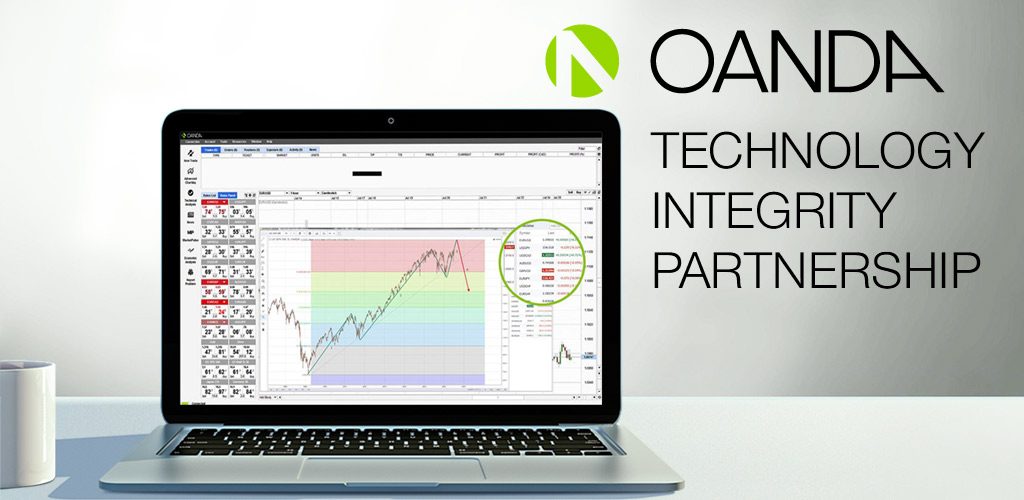
Key features:
- 80 indicators
- Connectivity to MetaTrader4, NinjaTrader, MotiveWave, MultiCharts
- MT4 open order indicator – to analyze market trends
- Historical spreads – min/max/avg spread data for set periods
- Price signals – set price up/down limits, or as simple moving average
- Trading performance portal – visualizations of profits, losses, risk/reward ratio, etc.
- Algo Labs site – for users to create own apps
- FXTrade mobile trading platform (Android, iOS)
There are certain considerations about Oanda as well. Accounts do not have protection against negative balance/slippage, average spreads do not reflect fixed time periods, in the EU the platform operates in a “broker” mode. Average CFD margin is 10% (see margin rules for more).
Pros
- Ability to open an account for just $1
- Wide array of currency pairs, asset classes
- API, mobile trading and more sophisticated tools
Cons
- Might be difficult for beginners
- Accounts with no slippage protection
- No CFDs for cryptocurrencies
Dukascopy
Account minimum: $5,000 | Max.leverage 1:100 | Avg.CFD margin: 1%
A Swiss online bank, Dukascopy Bank, provides web and mobile trading services, including CFD, foreign exchange, etc., banking services, technological solutions. It is under the regulation of Swiss supervisory body FINMA. Desktop trading platform, titled JForex 3, contains hundreds of indicators, news feed, historical testing. Through it or MT4 traders can implement automated and algorithmic strategies. Both demo and live accounts, although CFD trading is available only for regular live accounts. The minimum deposit for account is probably the highest among all CFD trading platforms – $5,000.
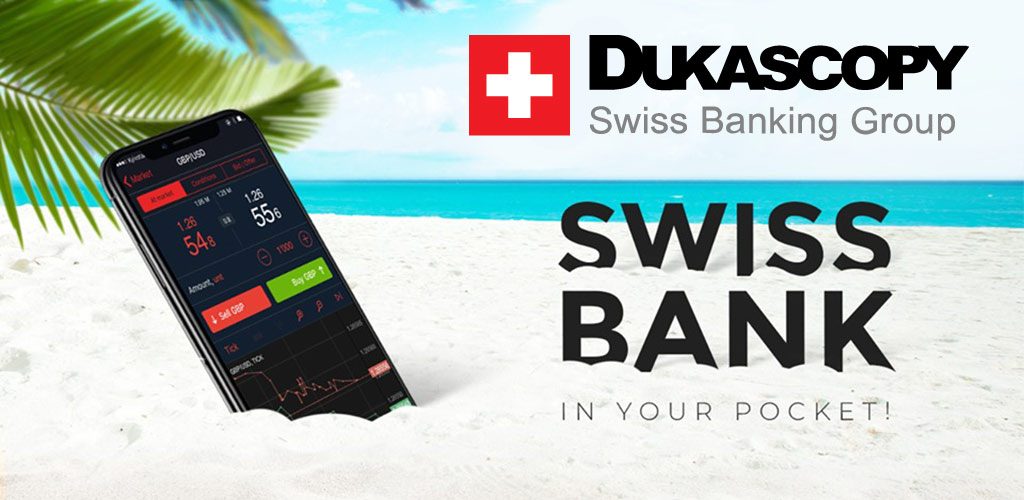
Key features:
- Markets: oil, gas, copper, 5 soft commodities, 18 indices, 2 bonds, liquid stock CFDs
- 24 trading hours for most instruments
- Equal prices and trading rights for all clients (marketplace model)
- Funding by credit card, deposits in 23 currencies
- Deposit protection by a bank up to 100,000 CHF
- MetaTrader 4 accounts support, 1:100 default leverage
- Swiss Forex marketplace – SWFX – a proprietary service by Dukascopy
- Fix API – to integrate, get real-time data and notifications, submit orders, etc.
- Help – wiki, tutorials, webinars, seminars
CFD prices are in correlation with SWFX marketplace price technology, and every client may impact a price by own bids and offers. Commissions are clearly defined, yet to calculate average spreads, one has to study daily/monthly/quarterly SWFX performance data. There are also additional account management fees, volume commissions, outgoing transfers fees, withdrawal fees, etc.
Pros
- JForex proprietary platform by a real Swiss bank
- Extensive research and analytic materials
- Good customer support 24/6
Cons
- Large initial deposit
- High commissions for low deposit traders
Summary
| CFD trading platforms: Main features | |||||||
| Demo account | Min.deposit | Min.fee | Total pairs | Max.leverage | Mobile app | API | |
| Capital.com | ✔️ | $20 | 0 | 2000+ | 1:200 | ✔️ | ✔️ |
| Oanda | ✔️ | $1 | N/A | 65 | 1:50 | ✔️ | ✔️ |
| Vantage FX | ✔️ | $200 | 0 | 40+ | 1:500 | ✔️ | – |
| Interactive Brokers | ✔️ | $0 | 0.05% | 85 | 1:500 | ✔️ | ✔️ |
| XTB | ✔️ | $250 | 0.08% | 60 | 1:30 | ✔️ | ✔️ |
| eToro | ✔️ | $50 | 0.09% | 96 | 1:30 | – | – |
| Plus500 | ✔️ | $100 | N/A | 84 | 1:30 | ✔️ | – |
| Dukascopy | ✔️ | $5,000 | 0.01% | 500+ | 1:100 | ✔️ | ✔️ |
As a bottom line, we are compelled to say that the choice of CFD platform depends on factors, such as broker expertise level, personal or business investment requirements, user interface preferences, markets and commission rates. That’s why there are more trading platforms beyond our list above, that are popular too. For instance, Poems by Phillip Capital is in demand in Asia-Pacific region, Muslim countries seem to prefer Orex by ADSS Securities. eToro fits well for beginners, while City Index and LCG Trader are favored by skillful investors.
Financial pundits predict further increase of CFD transactions in 2019-2020. CFD has its pros (access to global markets, lower margin rates, reasonable commissions and fees) and cons (high leverage, big risks of losing money), and therefore require a great deal of knowledge, trading experience and persistence.
P.S. Honorable mentions: AMarkets, City Index, LCG Trader, Orex, Poems, SaxoTrader, FxPro.
P.S.#2. You can trade CFD through Metatrader 4, Metatrader 5. Read a comparison of MT4 vs MT5.
Read next: 8 best stock trading platforms.
Disclaimer. All data for the article has been gathered from the official websites of aforementioned companies as of 01/07/2019. It may not be 100% accurate at the moment you are reading this review, other or extra fees may apply for trading activities. All trading platforms/apps/software are not affiliated to each other, and are solely responsible for their products. Any type of trading carries a substantial risk of loss.
CFD pros & cons
Benefits of CFD trading:
- Global market access. Today, all CFD platforms provide access to all major global markets, with round-the-clock activity.
- No shorting rules or borrowing stock. Some markets install rules that prohibit shorting, require traders to borrow the instrument before selling short, or margin requirements for short and long positions. CFD instruments, on the other hand, allow shorting any time without borrowing costs because traders do not own assets.
- No daily trading requirements. Unlike markets requiring a minimum amount of capital for daily trading or limiting daily transactions, CFD market is not bound this way, account holders can conduct day trading as they wish.
- Variety of trading opportunities. Brokers offer CFDs on stocks, indices, currencies and commodity contracts, any of which could be a decent alternative to exchanges.
- Execution without fees. The same types of orders as with traditional trading are offered, including stops, limits and conditional orders, e.g. “One Cancels the Other” and “If Done”. Some CFD platforms offer guaranteed stops that charge a service fee. Brokers earn money through spreads, and many of them do not charge any commissions or fees at all.
- Ability to earn money both via rising or falling prices.
Drawbacks:
- Weak regulation. CFD industry is not strictly regulated, broker reputation and proficiency is based largely on trust rather than government regulation.
- The risks. CFD trading is volatile and requires close monitoring. There are liquidity and margin risks that need to be maintained. If you cannot cover the cost reduction, a provider may close your position and you will have to cover the loss. Overall, risk of leverage exposes you to greater potential profit, as well as large potential loss. Although stop loss limits are available from many CFD providers, they cannot fully guarantee no loss.
- Spreads and commissions. Spread on entry and exit, basically, eliminates the possibility of profit from small transactions. Spread also reduces winning trades in relation to base price. Some brokers add hidden fees too.
FAQ
Q: What is CFD?
A: CFD is an intricate financial instrument, which is quite popular in countries like the UK, Austria, Switzerland, France, Germany, Russia, Singapore, Norway, etc., although not allowed in the USA, India. Its has compelling benefits, e.g. being a derivative tool – so no ownership of assets is required; less strict limitations for trading. Overall, there’s a lot to learn if you want to start trading differences. In trading, a contract for difference (CFD) is an agreement between a seller and a buyer on the asset value difference between the time of opening and closing a position.
Q: How does CFD work?
A: Consider two positive scenarios to see how contract for difference works. First scenario: Leverage 1:1, you buy a Tesla CFD contract for $180, after 2 months, if the contract is worth $240, you close the deal with a profit of $60, if no - with losses. Second scenario: Leverage 1:10, if you sell an AMD CFD contract for $34, and after 4 days the contract is worth $28, you close the trade with a profit nearly in 176.5%. Leverage in trading may increase profit substantially, however do not forget it also has the opposite effect – a risk of losing the investment, if forecast is incorrect. In the worst-case scenario, you might even end up with a negative balance. It is good though, due to competition, most brokers/platforms provide protection against negative balance. We recommend to apply a leverage of 1:10 maximum, as well as always have additional funds on a balance sheet, so that your contract does not close automatically before stock/contract growth.
Q: What is a CFD trading platform?
A: CFD trading platforms are computer programs that serve as a trading platform. They provide access to various trading types, to conduct transactions between traders directly or via an intermediary. CFD trading may involve stocks, currencies, commodities, shares, etc., and is always performed in pairs (USD to EUR, Shell to Exxon). By far the most popular platforms (a.k.a. brokers) are MetaTrader 4 and MetaTrader 5. These CFD platforms really have all the necessary functionality, but the list does not end on MetaTrader.
Q: What are the most popular CFD trading strategies?
A: The two most popular trading methods are short- and long-position, and sometimes “intertrading” in-between. Long position – purchase amid rising prices on the market. An exchange trading participant buys an asset in anticipation of value growth in the future. Short position – purchase in a downturn. This strategy is appropriate when, when a trader predicts a decline asset price. Thus, an asset is sold on condition of possible future purchase at the lowest price. If forecast was wrong, and asset price rises, traders would lose an amount equal to deviation between asset value at opening and closing of a transaction. If the forecast turns out to be correct, the bidder can make a profit, otherwise a loss. Such method makes it possible to bid on the shortest possible intervals, even within a minute.
Q: What CFD commissions and fees are there?
A: Commissions, fees, hidden fees, additional paid services, margins, spreads and more – all this you are going to encounter on trading platforms. Many CFD brokers may offer a choice of appropriate fees for your trading strategy. Optionally, there may be a guaranteed stop loss (for an additional fee) or other additional services and tools. Account inactivity, in many cases with CFD trading platforms, will be charged too. Therefore, we’d advise to carefully study all fees and commissions before choosing a platform. Let’s highlight one concrete example of what we may be dealing with. Take XTB Pro account, which we chose after consulting with Broker Chooser portal, helping to calculate fees of real CFDs as of 1 week sale. The condition was an asset purchased at $2,000, and 5:1 leverage. At the exit, when buying Apple Stock CFDs the commission is $18.1, when buying Vodafone CFDs – $24.4. Under Standard account, a trader would only pay higher spreads, and no other fees. You can get acquainted in detail with the table of XTB fees and commissions for this particular broker.
Q: How to calculate CFD fees?
A: There is no single formula for all CFD platforms/brokers, because one may earns on spreads, while another has additional commissions and fees. Many brokers provide their own formulas and even calculators for deducting fees.
Q: What are minimum deposits and withdrawals?
A: In order to start trading CFDs, you first need to open an account with a broker. Typically, you need to place between $0 to $10,000, depending on the broker. In light of competition, the initial deposit has been lowered to $0-250 in most cases. For deposit, Visa or MasterCard credit card, bank transfer, PayPal, and in some cases cryptocurrency, will do. In general, this process does not differ much from buying a product online, only here you may need to verify your identity. Withdrawal of funds occurs upon request, often to a credit card or a bank account. The amount, method and timing for withdrawal can also vary from broker to broker, so study their conditions beforehand.



